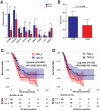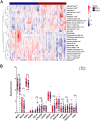Integrative Analysis of TLS-Associated Gene Signatures, Immune Infiltration and Drug Sensitivity in Pancreatic Cancer
- PMID: 41016829
- PMCID: PMC12476925
- DOI: 10.1049/syb2.70038
Integrative Analysis of TLS-Associated Gene Signatures, Immune Infiltration and Drug Sensitivity in Pancreatic Cancer
Abstract
Pancreatic adenocarcinoma (PAAD) remains highly lethal because of chemotherapy resistance and immunosuppressive microenvironments. Tertiary lymphoid structures (TLSs) were analysed in PAAD to develop personalised therapeutic strategies. Nine TLS-related genes (CCR6, CD1d, CD79B, CETP, EIF1AY, LAT, PTGDS, RBP5 and SKAP1) were selected for integrative analysis of TLS status in relation to clinical outcomes, immune cell infiltration, tumour mutational burden (TMB) and drug resistance. High TLS scores (TLS_H) were associated with improved overall survival (OS) and progression-free survival (PFS), independent of age or tumour grade. Twelve immune cell types differed across TLSs. Single-cell RNA-seq analysis revealed that the 9 TLS-related genes were enriched in distinct immune cell populations. Combining TLS and TMB improved survival prediction. Notably, the TLS_H group demonstrated enhanced sensitivity to chemotherapeutics including AZD8055, axitinib, vorinostat, nilotinib, camptothecin and paclitaxel. Real-time fluorescent quantitative PCR (RT-qPCR) validation in Mia PaCa2 and Jurkat cells indicated that LAT, RBP5 and SKAP1 may play important roles in modulating sensitivity to these chemotherapeutics. These findings establish TLS as a potential biomarker for PAAD, enabling personalised chemotherapy selection by integrating immune contexture and genomic drivers to improve clinical outcomes.
Keywords: bioinformatics; chemotherapy resistance; pancreatic cancer; tertiary lymphoid structures; tumour mutational burden.
© 2025 The Author(s). IET Systems Biology published by John Wiley & Sons Ltd on behalf of The Institution of Engineering and Technology.
Conflict of interest statement
The authors declare no conflicts of interest.
Figures









References
-
- Maddipati R. and Stanger B. Z., “Pancreatic Cancer Metastases Harbor Evidence of Polyclonality,” Cancer Discovery 5, no. 10 (2015): 1086–1097, 10.1158/2159-8290.cd-15-0120. - DOI - PMC - PubMed
Publication types
MeSH terms
Substances
Grants and funding
LinkOut - more resources
Full Text Sources
Medical
Research Materials
Miscellaneous

